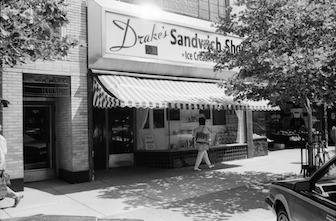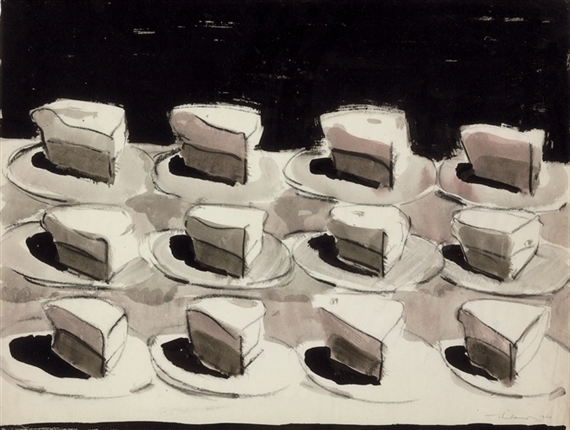Food Culture at the University of Michigan
The All-American culture of fast-food and diners that inspired the Pop Artists was a familiar phenomenon in Ann Arbor during the 1960's.
Wayne Thiebaud’s paintings exhibited at the University of Michigan’s New Realist Supplement encompassed popular American lunch counter foods that students enjoyed in the 1960s. Thiebaud’s depictions of these delicacies did not stray far from those enjoyed by Ann Arbor residents of the time. Students ducked into local restaurants such as The Roundtable for sweets and desserts (Moilanen 1991), Malli’s Coffee Cup for tea and pastries (Ann Arbor News 1962), or Mel’s Dining Room for Coney dogs and root beer (Ann Arbor News 1963).
One of the most popular spots to grab an all-American bite to eat was Drake’s Sandwich Shop, located on North University. Students wrote their orders on soda shop notepads and squeezed into high-walled booths, waiting for orange marmalade sandwiches or cherry cordials. Drake’s was not only popular among students, but was a gathering ground for police officers, professors, and residents of Ann Arbor as well. It was truly a staple in the city in Ann Arbor, as well as a reflection of food culture in its era (Tobin 2012).
Among the most popular menu items at Drake’s was a subject approached by Thiebaud in his New Realist Supplement paintings: pie. Thiebaud’s Shelf of Pies (1960) and Pieces of Pumpkin (1963) are reminiscent of the variety of sliced pie served at Drake’s, homemade by the “cake lady” Agnes Pangal in the basement of the shop (Kinsey 2010). Thiebaud’s Bologna and Cheese (1961) pictures food as the subject matter as well. The meat and cheese in the painting are unsliced, likely similar to the ingredients to the double-decker sandwiches served at Drake’s before preparation.
Thiebaud was not the only artist represented in the New Realist Supplement seeking subject matter from lunch counter food. Claes Oldenberg, like Thiebaud, approached the subject of pie, but in the form of sculpture in Slice of Pie (1962). Lunch counter food was not only a common subject in the New Realist Supplement, but also in Six Painters and the Object. In the latter, Pop Artist Roy Lichtenstein proved to be inspired by American food culture as well. Lichtenstein, though, portrayed another popular treat in Ice Cream Soda (1962).
To college students in the American South at this time, the lunch counter took on new meaning as the site of political protest. Student members of the civil rights movement staged the first sit-ins at segregated lunch counters, while sympathizers at the University of Michigan picketed local branches of the Kresge and Woolworth's chains in support.
- Jenna Barlage, RZ

